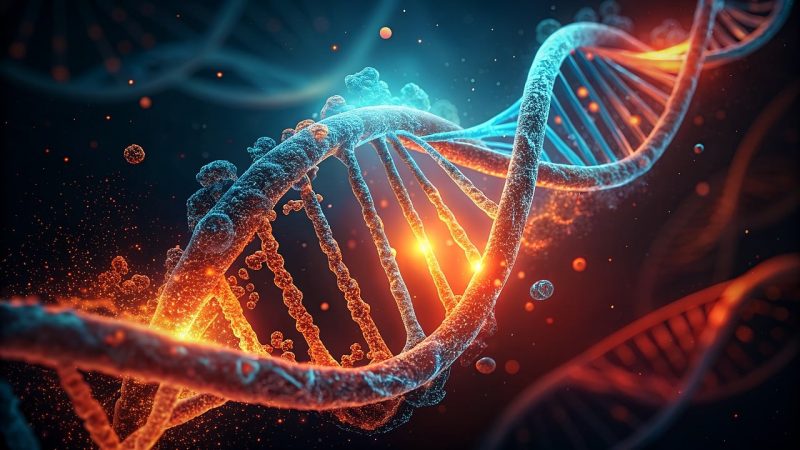Will the elite soon be able to order “designer babies” that are free from all genetic abnormalities and all genetic diseases because they have been created in a lab using “synthetic human DNA”? I realize that this may sound absolutely crazy to many of you, but we are dangerously close to such a scenario becoming a reality. Mad scientists that are extremely well funded are trying to “play God” by inserting large sections of “synthetic human DNA” into skin cells “to observe how they function”…
Scientists have taken a bold and controversial step toward creating synthetic human DNA from scratch, a move some critics liken to ‘playing God.’
The research aims to unlock new treatments for autoimmune disorders, heart failure, viral infections, and age-related diseases.
To do so, scientists are developing tools to build large, complex sections of human DNA in the lab and insert them into skin cells to observe how they function.
The ultimate goal is to construct entire human chromosomes, a foundational step toward assembling a fully synthetic human genome.
This is scary.
Once they are able to create a fully synthetic human genome, they will theoretically be able to create a fully synthetic human.
If you doubt this, you should consider the fact that scientists have already been able to create a fully synthetic bacterium…
Making synthetic genomes isn’t an entirely novel endeavor. Back in 2010, scientists managed to make from scratch the whole genome of a simple bacterium, and then plugged its genetic material inside an empty cell of another bacterium, making something entirely new that they cleverly dubbed Synthia. Scientists have also synthesized viral and yeast cells in other research.
Just because scientists are capable of doing something does not mean that they should actually do it.
Yes, maybe scientists can “play God” and make “perfect” synthetic humans that have no genetic diseases at all.
But would such creatures even be human?
Would they have souls like we do?
There are so many unanswered questions.
Unfortunately, nobody is going to hold these scientists back. In fact, many will eagerly embrace strange new technologies as the solution to the existential fertility crisis that we are now facing.
Since the 1970s, sperm counts all over the world have fallen precipitously…
Hagai Levine, an epidemiologist at the Hebrew University of Jerusalem, and his colleagues published an analysis in 2017 and an update in 2022 that evaluated a combined total of more than 200 studies that used a counting chamber. These two papers found about a 50 percent decrease in sperm concentration—most notably in Western countries—since the 1970s.
So what happens if we see another 50 percent decline over the next five decades?
Theoretically, average concentrations could eventually get so low that the majority of the male population is simply no longer capable of fathering children.
What would we do then?
As you will see below, there is concern that the accumulation of microplastics in our bodies could be one of the factors that is causing our fertility crisis.
Since 1950, over nine billion tons of plastic has been produced, and all of that plastic is constantly breaking down into smaller and smaller pieces…
More than nine billion tons of plastic are estimated to have been produced between 1950 and 2017, with over half of that total having been produced since 2004. The vast majority of plastic ends up in the environment in one form or another, where it breaks down, through weathering, exposure to UV light and organisms of all kinds, into smaller and smaller pieces, becoming microplastics and then nanoplastics.
Within our homes, microplastics are mainly produced when synthetic fibres from clothes, furnishings, carpets and other plastic objects are shed. They accumulate in large quantities in dust and float around in the air, which we then inhale.
If you are like most people, you literally use thousands of plastic products on a yearly basis.
One of the primary ways that microplastics get into our bodies is through the plastic packaging that most of our food is wrapped in…
A painstaking review of 103 scientific studies on microplastic food contamination found actions as simple as opening a plastic drink bottle or using a plastic chopping board can shave off tiny particles of common polymers.
Even glass bottles that use a plastic gasket, plastic-lined pizza boxes, plastic-lined disposable coffee cups, plastic tea bags, plastic wrappings, and microwaveable plastic containers shed microplastic like a Persian cat sheds fur in spring.
History will look back on us as the “crazy plastic people”.
Our plastic waste gets everywhere.
In fact, one team of researchers recently discovered that the deepest part of the Mediterranean Sea is absolutely littered with our plastic waste…
The Mediterranean has long been a crossroads of trade and tourism, yet its deepest pocket, the Calypso Deep, seemed beyond the reach of day-to-day pollution.
That hope ended earlier this year when researchers reported plastic bags, glass shards, and crumpled cans resting 16,770 feet beneath the waves in the Ionian Sea.
The researchers didn’t just find a few plastic items down there.
It is being reported that they literally found “thousands of objects per square mile”…
The team used the submersible Limiting Factor to reach the bottom of a kidney-shaped trench roughly 12.4 miles long and 3.1 miles across.
During a 43-minute trek near the seafloor of the Calypso Deep, cameras captured thousands of objects per square mile, mostly plastic waste discarded by humans.
A single straight-line pass of 2,130 feet was enough to confirm that human trash blankets large stretches of the basin. Most pieces were flexible plastics; glass, metal, and paper rounded out the list.
All of that plastic will continue breaking down forever.
And once plastic particles get small enough, it is easy for them to get into the human body.
One recent study actually found that the average human brain now contains “a spoon’s worth of tiny plastic shards”…
The human brain may contain up to a spoon’s worth of tiny plastic shards—not a spoonful, but the same weight (about seven grams) as a plastic spoon, according to new findings published Monday in the journal Nature Medicine.
Researchers detected these “almost unbelievable” levels of microplastics and nanoplastics in the brains of human cadavers, says study co-author Andrew West, a neuroscientist at Duke University, to Science News’ Laura Sanders. “In fact, I didn’t believe it until I saw all the data.”
Based on their analysis, the amount of microplastics in the human brain appears to be increasing over time: Concentrations rose by roughly 50 percent between 2016 and 2024.
Our heads are literally filling up with plastic.
This may be one of the primary reasons why most people can’t seem to think straight these days.
Scientists have also discovered that microplastics are accumulating in our reproductive fluids…
Tiny bits of plastic no wider than a human hair have turned up in some unexpected places, including the human bloodstream.
Now, data presented at the European Society of Human Reproduction and Embryology meeting shows that these fragments have breached the fluids that surround eggs and travel with sperm.
The research team led by Dr. Emilio Gómez‑Sánchez of Next Fertility Murcia in Spain scanned follicular fluid from 29 women and seminal fluid from 22 men.
The experts found microplastics in 69 percent of the women and 55 percent of the men they studied. According to Dr. Gómez‑Sánchez, the team was surprised to find that the particles were so widespread.
It is going to take time for scientists to determine exactly how these microplastics are affecting our reproductive health, but at this point they are not optimistic at all…
The impact these microplastics — defined as plastic particles under 5 millimeters in size — have on reproductive health is unclear, but it’s unlikely to be anything good.
“What we know from animal studies is that in the tissues where microplastics accumulate, they can induce inflammation, free radical formation, DNA damage, cellular senescence and endocrine disruptions,” Gomez-Sanchez said.
Of course even if microplastics did not exist, there are so many other threats to our reproductive health these days.
The constant levels of electromagnetic radiation we are being bombarded with and the poisons in our food are just two of them.
Nobody can deny that we are in a crisis, because that is what the numbers are clearly telling us. This is something that Robert F. Kennedy Jr. commented on recently during an interview with Fox News…
“We have fertility rates that are just spiraling. A teenager today, an American teenager, has less testosterone than a 68-year-old man. Sperm counts are down 50%,” he told Fox News’ Jesse Watters in April, adding: “It’s an existential problem.”
I fully agree.
Humanity really is facing an existential fertility crisis.
But creating “synthetic human DNA” from scratch is not the solution.
“Playing God” never works out well in the end.
Hopefully our scientists will realize this before it is too late.
Michael’s new book entitled “10 Prophetic Events That Are Coming Next” is available in paperback and for the Kindle on Amazon.com, and you can subscribe to his Substack newsletter at michaeltsnyder.substack.com.
About the Author: Michael Snyder’s new book entitled “10 Prophetic Events That Are Coming Next” is available in paperback and for the Kindle on Amazon.com. He has also written nine other books that are available on Amazon.com including “Chaos”, “End Times”, “7 Year Apocalypse”, “Lost Prophecies Of The Future Of America”, “The Beginning Of The End”, and “Living A Life That Really Matters”. When you purchase any of Michael’s books you help to support the work that he is doing. You can also get his articles by email as soon as he publishes them by subscribing to his Substack newsletter. Michael has published thousands of articles on The Economic Collapse Blog, End Of The American Dream and The Most Important News, and he always freely and happily allows others to republish those articles on their own websites. These are such troubled times, and people need hope. John 3:16 tells us about the hope that God has given us through Jesus Christ: “For God so loved the world, that he gave his only begotten Son, that whosoever believeth in him should not perish, but have everlasting life.” If you have not already done so, we strongly urge you to invite Jesus Christ to be your Lord and Savior today.

